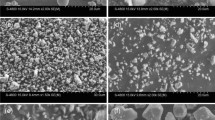Abstract
Nitrides of transition metals have good wear- and corrosion-resistant properties because of their high hardness and chemical stability. Chromium-nitride coatings can be deposited by ion plating; however, the thin thickness due to the slow deposition rate must be improved for severe wear-resistant applications. The main objective in this paper is to realize good structural control in the processing of chromiumnitride in situ composite coatings formed at a high deposition rate. They were synthesized by reactive low-pressure plasma spraying using elemental chromium powder as a spray material. The transferred arc between the gun electrode and the substrate was used to accelerate the nitriding reaction. The sprayed coatings consist of chromium, Cr2N, and CrN, which have a composition gradient from the substrate interface to the surface. The volume fraction of Cr2N increases with transferred arc current, and nonreacted chromium concurrently decreases, except close to the substrate. The CrN phase, however, only exists as a surface layer of 20 to 30 μm because it is decomposed to Cr2N above 1420 K. The hardness of the composite coatings depends on the volume fraction of Cr2N, and it increases to 1300 HV at a Cr2N volume fraction of 0.98. The seizure stress with lubricant depends on the coating hardness. The maximum seizure stress of 24.9 MPa is obtained at a hardness of 1300 HV. The composite coatings also show a superior wear resistance. Hence, the Cr2N in situ composite coatings synthesized by reactive plasma spraying with transferred arc are expected to be good candidates for wear-resistant applications.
Similar content being viewed by others
References
S. Komiya, S. Ono, N. Umezu, and T. Narusawa, Characterization of Thick Chromium-Carbon and Chromium-Nitrogen Films Deposited by Hollow Cathode Discharge,Thin Solid Films, Vol 45, 1977, p 433–445
T. Sato, M Tada, Y.C. Huang, and H. Takei, Physical Vapor Deposition of Chromium and Titanium Nitrides by the Hollow Cathode Discharge Process.Thin Solid Films, Vol 54, 1978, p 61–65
O. Knotek, W. Bosch, M. Atzor, W.-D. Munz, D. Hoffmann, and J. Goebel. Properties of Chromium Nitrides Deposited by Reactive Sputtering,High Temp.—High Press., Vol 18, 1986, p 435–442
O. Knotek, F. Loffler, and H.J. Scholl, Properties of Arc-Evaporated CrN and (Cr, Al) N Coatings,Surf. Coat. Techno!., Vol 45, 1991, p 53–58
M. Taguchi and H. Takahashi, Corrosion Behaviour of Chromium Nitride Films Produced by Reactive Ion Plating in Sulfuric Acid Solution,J.Jpn. Inst.Met., Vol 56, 1992, p 1221–1227 (in English and Japanese)
P. Ballhause, H. Hensel. A. Rost, and H. Schssler, CrNx—A Hard Coating for Corrosion and Wear Resistance,Maler. Sci. Eng. A, Vol 163, 1993, p 193–196
J. Goebel, Some Examples for the Application of Surface Analysis Techniques in Thin Film Technology,Z. Anal. Chem., Vol 319, 1984, p 771–776 (in English and German)
T. Mills, Pressure-Temperature Relations in the Chromium-Nitrogen System,J Less-Common Mel., Vol 22,1970, p 373–381
H. Holleck,Binary and Ternary Carbide and Nitride Systems of Transition Metals, Gebruder Borntraeger, 1984, p 45
Y.L. Su and J.S. Lin, An Investigation of the Tribological Potential of TiN, CrN and TiN+CrN Physical Vapor Deposited Coatings in Machine Element Applications,Wear, Vol 170, 1993, p 45–53
E. Takasaka and S. Iwamoto, Preferential Crystal Orientation of Chromium Nitrided Films Prepared by IBED Method,J. Jpn. Inst. Met.. Vol 57,1993, p 417–420 (in English and Japanese)
Y. Tsunekawa, K. Gotoh, M. Okumiya. and N. Mohri, High-Temperature Stability of Titanium Aluminide Matrix Composites Fabricated by Reactive Low Pressure Plasma Spraying,Thermal Spray: International Advances in Coatings Technology, C.C. Berndt, Ed., ASM International, 1992, p 189–194
Y. Tsunekawa, K. Gotoh, M. Okumiya, and N. Mohri, Synthesis and High-Temperature Stability of Titanium Aluminide Matrix in situ Composites,J Therm. Spray Technol, Vol 1, 1992, p 223–230
Y Tsunekawa, M. Okumiya, K. Gotoh, T. Nakamura, and I. Niimi, Synthesis of Iron Aluminide Matrix in situ Composites from Elemental Powders by Reactive Low Pressure Plasma Spraying,Mater. Sci. Eng. A, Vol 159, 1992, p 253–259
M. Fukumoto, S. Katoh, and I. Okane, Splat Behavior of Plasma Sprayed Particles on Flat Substrate Surface,Thermal Spraying: Current Status and Future Trends. A. Ohmori, Ed., High Temperature Society of Japan, 1995, p353–358
Author information
Authors and Affiliations
Rights and permissions
About this article
Cite this article
Tsunekawa, Y., Okumiya, M., Kobayashi, T. et al. Chromium-nitride in situ composites with a compositional gradient formed by reactive DC plasma spraying. JTST 5, 139–144 (1996). https://doi.org/10.1007/BF02646427
Issue Date:
DOI: https://doi.org/10.1007/BF02646427




